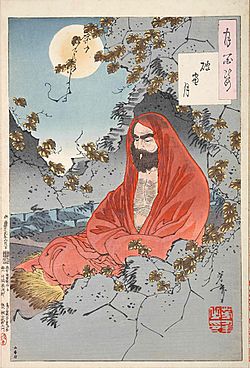Bodhidharma facts for kids
Quick facts for kids Bodhidharma |
|
|---|---|

Bodhidharma, Ukiyo-e woodblock print by Tsukioka Yoshitoshi, 1887.
|
|
| Religion | Buddhism |
| School | Chan |
| Senior posting | |
| Title | Chanshi 1st Chan Patriarch |
| Successor | Huike |
| Religious career | |
| Students | Huike |
Bodhidharma was a famous Buddhist monk who lived a long time ago, around the 5th or 6th century. He is known for bringing a special kind of Buddhism called Chan Buddhism to China. He's also seen as the very first leader, or 'patriarch,' of this type of Buddhism in China.
According to Chinese stories, Bodhidharma also started the physical training for the monks at the Shaolin Monastery. This training eventually led to the creation of Shaolin kungfu, a famous martial art. In Japan, people know him by the name Daruma.
Contents
Who Was Bodhidharma?
Bodhidharma is believed to have come from a region called the Western Regions. This area usually refers to Central Asia, but it could also include the Indian subcontinent. Some stories say he was from Persia in Central Asia, while others say he was a prince from South India. He was said to be the third son of a great Indian king.
How Bodhidharma is Shown
In Buddhist art, Bodhidharma is often shown as a serious-looking person with a big beard and wide eyes. He is sometimes called "The Blue-Eyed Barbarian" in old texts. This description highlights that he was seen as different from the local Chinese people.
When Did He Arrive in China?
The exact time Bodhidharma arrived in China is a bit unclear. Some early records say he came during the Liu Song dynasty (420–479). Later stories suggest he arrived during the Liang dynasty (502–557). Most of his work happened in the area controlled by the Northern Wei (386-634). Today, experts think he probably arrived around the early 5th century.
Bodhidharma's Teachings
Bodhidharma's main focus was on meditation. He believed that through deep meditation, people could find inner peace and understanding. He also taught using a special Buddhist text called the Laṅkāvatāra Sūtra.
The Line of Patriarchs
An important book from 952, called the Anthology of the Patriarchal Hall, says that Bodhidharma was the 28th leader in a long line of Buddhist teachers. This line is believed to go all the way back to Gautama Buddha himself, the founder of Buddhism. This means he was a very important figure in the history of Buddhism.
Images for kids
-
This image shows Sogdians, an Eastern Iranian people, in a cave temple. They lived in Turfan as a minority during the Tang Chinese and Uyghur rule.
-
A sandstone statue from the Ming dynasty (1368 - 1683) showing Bodhidharma seated. This statue was made in 1484.
-
This Japanese scroll calligraphy of Bodhidharma reads, "Zen points directly to the human heart, see into your nature and become Buddha." It was created by Hakuin Ekaku (1686 to 1769).
-
A stone carving of Bodhidharma at the Shaolin Monastery.
-
Dazu Huike offering his arm to Bodhidharma. This ink painting was created by Sesshū Tōyō in 1496, during the Muromachi period in Japan.
-
A statuette of Bodhidharma from the Qing dynasty (1644 - 1911), made in the 19th century.
-
A painting of Bodhidharma at Himeji Castle in Japan, from the Edo period.
-
A Dehua ware porcelain statuette of Bodhidharma from the late Ming dynasty, 17th century.
-
Bodhidharma, also known as Daruma, painted by Miyamoto Musashi. He was a famous swordsman, artist, and philosopher.
See also
 In Spanish: Bodhidharma para niños
In Spanish: Bodhidharma para niños











